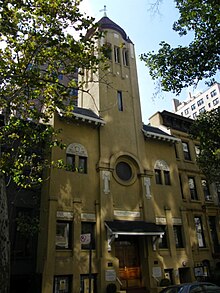| First Hungarian Reformed Church of New York | |
|---|---|
 North elevation, 2008 | |
| Religion | |
| Affiliation | United Church of Christ |
| Leadership |
|
| Location | |
| Location | Upper East Side, New York, NY, USA |
| Geographic coordinates | 40°45′58″N 73°57′30″W / 40.76611°N 73.95833°W |
| Architecture | |
| Architect(s) | Emery Roth |
| Style | Hungarian vernacular |
| General contractor | McDermott & Henigan |
| Completed | 1916 |
| Specifications | |
| Direction of façade | North |
| Width | 35 feet (11 m)[1] |
| Spire(s) | 1 |
| Spire height | 80 feet (24 m)[1] |
| Materials | Stucco, brick |
| U.S. National Register of Historic Places | |
| Added to NRHP | August 31, 2000 |
| NRHP Reference no. | 00001012[2] |
| Website | |
| Official website | |
The First Hungarian Reformed Church of New York (Hungarian: New York-i Első Magyar Református Egyház) is located on East 69th Street in the Upper East Side of the New York City borough of Manhattan. It is a stucco-faced brick building, completed in 1916 in a Hungarian vernacular architectural style, housing a congregation established in 1895.
It is the only Christian religious building designed by Hungarian-born architect Emery Roth, later known for his apartment buildings on Central Park West.[1] As one of two Hungarian Reformed Churches in Manhattan, it has been a focal point for the city's Hungarian-American community since its construction.
In 1983, its parsonage was listed on the National Register of Historic Places as a contributing property to the Rowhouses at 322–344 East 69th Street historic district to its immediate west. The parsonage was listed in its own right along with the church in 2000. Following the demolition of the German Evangelical Reformed Church a block to the south, it became the oldest church in the neighborhood.[1]
- ^ a b c d Howe, Kathy (June 1, 2000). "National Register of Historic Places nomination, First Hungarian Reformed Church of New York". New York State Office of Parks, Recreation and Historic Preservation. Retrieved December 2, 2010.
- ^ "National Register Information System". National Register of Historic Places. National Park Service. March 13, 2009.